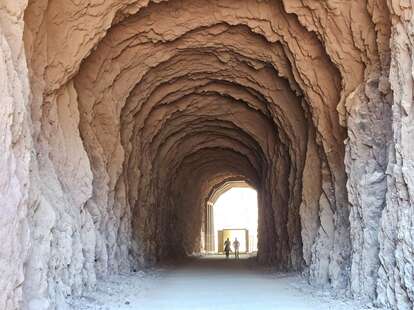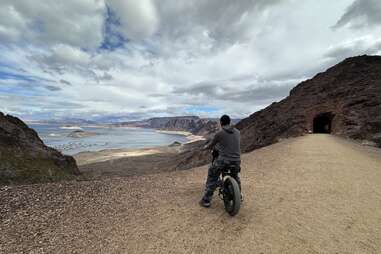Explore the Train Tunnels That Built the Hoover Dam
The historic train tunnels that built the Hoover Dam are now a gorgeous hiking trail.

What is the best way to visit the Hoover Dam? Take the back entrance. The Historic Railroad Tunnel Trail is more than just a great reason to visit Boulder City. It's one of the most unique hikes in Southern Nevada, mixing incredible scenery with history and what everybody really wants—a few cool photo spots.
The trail spans about 3.5 miles, retracing the route where railroad tracks once delivered supplies to workers constructing the Hoover Dam. You'll pass through five tunnels carved from volcanic rock while overlooking Lake Mead itself. It's a great place to jog, stroll, or even walk your dog, but taking an e-bike tour is the most fun of all.
"I love the thrill of it," said Rian Burress of Cityscape Cycling, the only company licensed to lead e-bike tours on the trail. "It's a fun way to see the dam without driving here."
The trail is just one segment of a 20-mile network of railroads built in 1931 to haul materials to the site of the Hoover Dam (initially known as the Boulder Dam). Trains ran 24 hours a day, carrying gravel, machinery, and other items to complete the project ahead of schedule and under budget in five years. How's that for government productivity

For the most part, the trail follows gentle grades because dramatic elevation shifts weren't ideal for transporting heavy loads. That leaves behind a route today that's easy to navigate on the Super73-ZX bikes used by Cityscape Cycling. The vehicles, a cross between a traditional bicycle and a dirtbike, are charged for added assistance while pedaling and include a motorized thrust that's controlled by the right hand–especially helpful when zipping over the dust that collects in the tunnels. Between a padded seat and wide tires, the experience adds up to a comfortable ride that deftly handles loose gravel and dirt.
The trail narrows at times with a steep dropoff along the sides, but it never feels dangerous. It's a quiet, serene environment—a sharp contrast to the 1930s when the railway operated alongside Ragtown, a Depression-era village built of wood cabins, tattered tents, and cardboard dwellings for hundreds seeking work at the dam. Families would haul water up from the Colorado River to cook meals and clean clothes

Now, Ragtown is gone, but the tunnels remain, built in just five months by crews in scorching summer temperatures more than 90 years ago. It's hard not to marvel at their size. Each one spans about 300 feet long, 18 feet wide, and 27 feet tall so that trains could carry large pieces of pipe and construction equipment to the site. A few of the tunnels were reinforced with timber to prevent fractured rock from falling on rail cars and workers. Some of that wood was destroyed by fire in 1990 but replaced and reinforced with shotcrete, a sprayable, stronger version of concrete.
The tunnels aren't entirely empty these days. Mexican Free-Tailed Bats roost in the darkness between May and October each year. The creatures consume thousands of insects, which cuts down on summer bugs, so be grateful they're hanging around. "We have lights on the bikes, but aren't allowed to use them," Burress says, noting headlights could disturb bats.
Coyotes and bighorn sheep rustle throughout the foothills that run alongside the trail but generally keep their distance from humans. You're more likely to spot smaller animals like lizards, ravens, and quail. Most tend to avoid the heat of daylight and are easier to notice around dawn and dusk

The Historic Railroad Tunnel Trail begins at the Lake Mead National Recreation Area Visitors Center, just outside the park gates, so there's no entrance fee to worry about. A second entrance connects from the nearby Hoover Dam Lodge & Casino about a mile into the hike. The unobstructed views of Lake Mead are spectacular, showcasing the very reason for the Hoover Dam's existence.
The path becomes more rugged as it shifts from National Park Service land to Bureau of Land Management territory, eventually passing by an outdoor exhibit known informally as the Hoover Dam Boneyard, where large pieces of discarded machinery are displayed. Listen carefully, and you'll hear the sizzle of electricity coursing through a power station that processes electricity from the dam.

The trail ends at the Hoover Dam parking garage, which sits in the same spot where a plant produced concrete for the site between 1932 and 1934. Back then, trains would dump their cargo of sand and gravel directly into the facility in a model of efficiency that feels envious by today's standards.
Any bikes (or e-bikes) have to be parked and locked before walking down a steep descent and staircase to the Hoover Dam, where you can take part in an official tour, scope out a perfect spot for photographs, or walk across the top of the dam itself, which stretches more than 700 feet tall on the border between Nevada and Arizona.
Feel free to fuel up on a snack at the gift shop. You've got another 3.5 miles to double back to where you started–and the journey is worth every minute of your time.